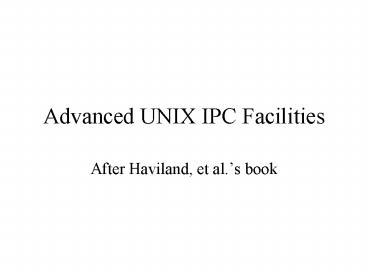Advanced UNIX IPC Facilities - PowerPoint PPT Presentation
1 / 11
Title:
Advanced UNIX IPC Facilities
Description:
UNIX offers a variety of advanced IPC mechanisms. This makes UNIX an extremely rich system in the ... Message queue will not be overwritten if it already exists ... – PowerPoint PPT presentation
Number of Views:124
Avg rating:3.0/5.0
Title: Advanced UNIX IPC Facilities
1
Advanced UNIX IPC Facilities
- After Haviland, et al.s book
2
Introduction and Basic Concepts
- UNIX offers a variety of advanced IPC mechanisms
- This makes UNIX an extremely rich system in the
IPC area - Allows developer to use a variety of approaches
when programming a system made up of cooperating
tasks
3
Categories of advanced IPC
- Message passing
- Semaphores
- Shared memory
4
IPC facility keys
- UNIX has made the 3 categories of IPC as similar
as possible for programming convenience - The most (?) important similarity is the IPC key
- Keys are numbers used to identify an IPC object
on a UNIX system - Much like a file name being used to identify
files - Key allows IPC object to be shared by several
processes
5
Difference between keys and file names
- Keys are not file names and carry less meaning
- Actual key type is determined by implementation,
and defined by key_t in ltsys/types.hgt - UNIX uses a simple library funciton that maps a
files pathname to a key - Routine is called ftok( )
6
IPC get operation
- With the get operation, a program uses a key to
- Create an IPC, or,
- Gain access to an existing one
Mqid msgget((key_t)0100, 0644IPC_CREATIPC_EXCL
)
For semaphores semget For shared mem shmget
Msg queue key
Non-neg id returned if successful
7
Other IPC Operations
- Control operations
- Get status information
- Set control values
- Actual calls are msgctl, semctl, shmctl
- More specific operations to perform various
functions - Do interesting work
- Called IPC operations
- For example, for message queues we have
- Msgsend
- msgrcv
8
Status data structures
- When an IPC object is created, the system also
creates an IPC facility status structure - This contains any administrative info assoc with
object - There is one type of status structure for
messages, semaphores and shared mem - However all 3 contain a common permission
structure, ipc_perm
9
Message passing
- A message is basically a sequence of characters
of bytes, not necessarily null-terminated - One process creates a message queue using msgget
- One a queue is established, a process with the
right permissions can put messages into it with
msgsnd - Another process can then read this message with
msgrcv
10
Form of msgget
include ltsys/msg.hgt int msgget(key_t key, int
permflags)
11
Permflags
- Determines the exact action perform by msgget
- Two constants are relevant here, defined in
ltsys/ipc.hgt - Can be used alone or ORed together
- IPC_CREAT
- Tells msgget to create a message queue for the
value key if one doesn't exist - Message queue will not be overwritten if it
already exists - If not set, then msgget returns id of existing
msgqueue, if exists - IPC_EXCL
- If this and IPC_CREAT are both set, then only
intend to create new msgqueue - Return -1 if already exists































